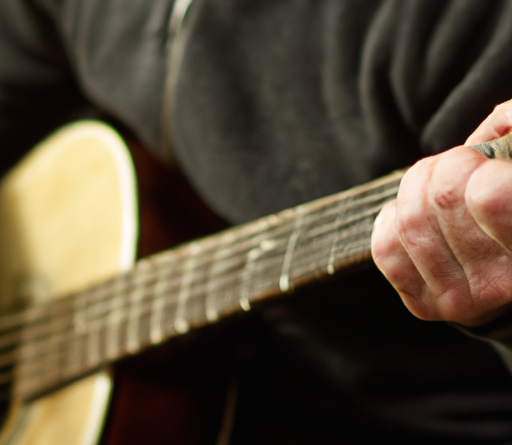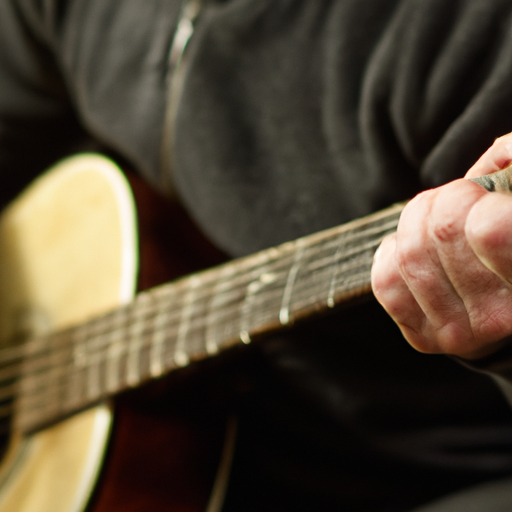
So, you’ve got a guitar and you’re ready to start playing some music. That’s great! But now you might be wondering, how exactly do I play music on this thing? Well, don’t worry, because I’ve got you covered. In this article, we’re going to dive into the world of playing music on the guitar and I’ll walk you through the basics so that you can start strumming away in no time.
First things first, let’s talk about the different components of the guitar. You’ve got the body, the neck, the frets, and the strings. Each of these elements plays a crucial role in producing those beautiful melodies. We’ll go into more detail about how each of these parts works together to create music in the article, so stay tuned!
Now, I know that learning to play music on the guitar can seem intimidating, especially if you’ve never picked up an instrument before. But fear not! I’m here to tell you that with a little bit of practice and patience, you’ll be playing your favorite songs in no time. We’ll cover everything from tuning your guitar to strumming patterns and chord progressions. By the end of this article, you’ll have the knowledge and skills to start playing music on your guitar confidently.
So, if you’re ready to embark on this musical journey with your guitar, keep reading! In the following sections, we’ll delve deeper into the world of guitar playing and explore everything you need to know to get started. From learning how to play simple melodies to mastering complex chords, this article will be your ultimate guide to playing music on the guitar. So grab your guitar and let’s get started!
Table of Contents
How to Play Music on Guitar
Learning to play music on the guitar is an exciting journey that offers countless benefits. Whether you’re a beginner or have some experience, the guitar provides a creative outlet, improves cognitive skills, and allows for emotional expression. In this guide, we will take you through the steps to get started with playing music on the guitar, learn basic techniques, chords, scales, and even explore different genres. By following this guide, you will be on your way to confidently playing music on the guitar and enjoying the endless possibilities of this versatile instrument.

Benefits of Playing Music on Guitar
Improves cognitive skills
Playing music on the guitar has been proven to enhance cognitive skills. Research has shown that playing an instrument can improve memory, attention span, and problem-solving abilities. It also stimulates areas of the brain responsible for language processing, spatial-temporal skills, and creative thinking. Learning to play music on the guitar exercises your brain in a unique way, making you more mentally sharp and agile.
Enhances creativity
One of the greatest benefits of playing music on the guitar is the opportunity for self-expression and creativity. The guitar allows you to explore different sounds, melodies, and rhythms, enabling you to create your own music. Whether you’re strumming chords, picking individual notes, or playing a solo, the guitar offers endless possibilities for artistic expression. It’s a medium through which you can convey your emotions and connect with others on a deeper level.
Provides emotional outlet
Music has the power to evoke emotions and provide a means of emotional release. Playing the guitar can be a cathartic experience, allowing you to channel your emotions into your playing. Whether you’re feeling happy, sad, or angry, playing music on the guitar can provide an outlet for those emotions. It’s a form of self-expression that can be therapeutic and healing. In addition, music has the ability to uplift your mood and bring joy and relaxation into your life.
Getting Started with Playing Music on Guitar
Before diving into playing music on the guitar, it’s important to understand the basics. This section will guide you through choosing the right guitar, understanding guitar anatomy, and tuning the guitar.
Choosing the right guitar
When starting your guitar journey, it’s crucial to choose the right guitar for you. There are different types of guitars, such as acoustic, electric, and classical, each with its own sound and playing style. Consider your musical preferences and goals when selecting the type of guitar. Acoustic guitars are great for playing folk, pop, and country music, while electric guitars are suited for rock, blues, and metal. Classical guitars are ideal for classical and fingerstyle playing. Visit a local music store or seek advice from experienced guitar players to find the perfect fit.
Understanding guitar anatomy
To play music on the guitar, it’s essential to have a basic understanding of its anatomy. The main parts of the guitar include the body, neck, fretboard, strings, and headstock. The body is the hollow or solid portion of the guitar that amplifies the sound. The neck connects the body to the headstock and houses the fretboard. The fretboard consists of metal frets, where you press down the strings. The strings are typically made of steel or nylon and are responsible for producing sound. The headstock holds the tuning pegs, which are used to adjust the tension of the strings.
Tuning the guitar
Before you start playing, it’s crucial to tune your guitar. A properly tuned guitar ensures that you achieve the correct pitch while playing. There are different methods to tune a guitar, such as using an electronic tuner, tuning app, or tuning by ear. An electronic tuner is the most accurate and convenient option for beginners. It detects the pitch of each string and guides you to adjust the tension until the desired pitch is reached. Tuning apps on smartphones also provide a similar function. Alternatively, you can tune your guitar by ear by comparing the sound of each string to a reference note. This method requires a trained ear and may take some time to master.
Basic Guitar Techniques
Once you have your guitar set up and in tune, it’s time to learn some basic techniques that form the foundation of playing music on the guitar. This section will cover holding the guitar properly, finger placement on the fretboard, and different strumming techniques.
Holding the guitar properly
Proper guitar posture and positioning is crucial for good technique and avoiding discomfort or injury. Start by sitting on a chair with a straight back and placing the guitar on your right leg (if you’re right-handed). The waist of the guitar should rest on your right thigh, while the neck is angled slightly upwards. Your left hand will be positioned on the fretboard, and the right hand will be responsible for strumming or picking the strings. It’s important to find a comfortable position that allows you to reach all the strings and frets easily.
Finger placement on the fretboard
To play music on the guitar, you need to understand the concept of frets and how to place your fingers correctly on the fretboard. The frets divide the neck of the guitar into specific segments, and pressing down a string against a fret creates a different pitch. Start by placing your index finger behind the first fret, close to the metal bar. Your fingers should be arched, pressing down on the strings with the fingertips, not the pads. As you progress, you’ll need to learn different finger placements for various chords and scales.
Strumming techniques
Strumming is an essential technique that allows you to produce a rhythmic sound on the guitar. To start, hold a pick between your thumb and index finger. Position your hand above the soundhole, and use a downward or upward motion to strum across the strings. The speed and intensity of your strumming will depend on the style of music you’re playing. Practice strumming patterns and alternate between upstrokes and downstrokes to develop a sense of rhythm and control.
Learning Guitar Chords
Chords are the building blocks of music on the guitar and form the backbone of most songs. This section will cover open chords, barre chords, and power chords.
Open chords
Open chords are basic chords that are played in the first few frets of the guitar. Some common open chords include C, G, D, E, and A. These chords are called “open” because they incorporate open strings (unfretted strings that are played). Open chords are relatively easy to play and are commonly used in various genres of music. Learning these chords will allow you to play many popular songs.
Barre chords
Barre chords involve using a finger to press down multiple strings across the fretboard, creating a movable chord shape. Barre chords are more challenging than open chords but offer greater versatility and the ability to play in any key. Some common barre chords include F, B, C#, and G#. By mastering barre chords, you can play a wide range of songs and expand your guitar playing abilities.
Power chords
Power chords are stripped-down, two-note chords that are commonly used in rock and metal music. They consist of the root note and the fifth note of a chord, omitting the third note. Power chords are played by barring a single finger across the appropriate fret, usually on the lower strings. They are easy to play and provide a powerful, distorted sound. Learning power chords opens up opportunities to play and perform in the rock and metal genres.

Playing Popular Songs on Guitar
Once you have a good grasp of basic chords, you can start playing popular songs on the guitar. This section will cover learning to read tabs and chord charts, playing chords along with songs, and adding embellishments and variations.
Learning to read tabs and chord charts
Tabs (tablature) and chord charts are two common methods used to notate music for the guitar. Tabs show the strings and frets to be played, indicating the order and timing of notes. Chord charts display the chord diagrams, showing finger placements and strumming patterns. By learning to read tabs and chord charts, you can quickly learn how to play your favorite songs.
Playing chords along with songs
Many songs are based on a combination of chords and can be played by strumming these chords in the correct sequence. Start by choosing songs that have beginner-friendly chords and gradually progress to more complex songs. With practice and repetition, you’ll develop muscle memory, making it easier to transition between chords smoothly and play along with your favorite songs.
Adding embellishments and variations
Once you feel comfortable playing chords, you can start adding embellishments and variations to make your playing more dynamic. Embellishments include hammer-ons, pull-offs, slides, and bends. These techniques add flavor and interest to your playing and can help you replicate the original recording or add your personal touch.
Improving Finger and Hand Coordination
To become a proficient guitarist, you need to develop finger and hand coordination. This section will explore practicing finger exercises, developing dexterity, and building strength.
Practicing finger exercises
Finger exercises are an integral part of guitar practice. They help improve finger strength, flexibility, and coordination. Start with simple exercises like finger stretches, fingerpicking patterns, and chromatic exercises. Gradually increase the difficulty level as you build strength and dexterity in your fingers.
Developing dexterity
Dexterity refers to the agility and speed with which your fingers can move independently on the guitar fretboard. Developing dexterity involves practicing scales, arpeggios, and complex finger patterns. Regular practice of these exercises will enhance your finger coordination and enable you to navigate the guitar with ease and precision.
Building strength
Playing the guitar requires finger strength, especially when pressing down on the strings to form chords and play individual notes. You can build strength by practicing chord shapes and doing finger exercises that target specific muscle groups. As your finger strength improves, you’ll find it easier to play more complex chords and techniques.
Understanding Guitar Scales and Modes
A solid understanding of scales and modes is essential for playing melodies, improvising, and creating your own music on the guitar. This section will cover major and minor scales, pentatonic scales, and modes such as Ionian, Dorian, and Mixolydian.
Major and minor scales
Major and minor scales are the foundation of Western music and provide a framework for melodies and harmonies. The major scale has a bright and happy sound, while the minor scale has a more melancholic and emotional quality. By learning different shapes and fingerings of major and minor scales, you can explore different tonalities and create melodies that fit well with various chords.
Pentatonic scales
Pentatonic scales are five-note scales widely used in a variety of musical genres. They are often favored for soloing and improvisation due to their versatility and ease of use. The pentatonic scale patterns can be moved up and down the fretboard, allowing for playing in different keys. Learning these patterns and incorporating them into your playing will open up a world of possibilities for creating your own guitar solos.
Modes (Ionian, Dorian, Mixolydian)
Modes are variations of the major scale and allow for different tonalities and moods. The most common modes include Ionian, Dorian, and Mixolydian. Each mode has its characteristic sound and can be applied to different styles of music. By delving into modes, you can add complexity and richness to your playing, expanding your improvisation skills and musical vocabulary.
Exploring Different Genres on Guitar
The guitar is a versatile instrument that can be found in numerous music genres. This section will explore blues guitar techniques, rock and metal guitar styles, as well as fingerstyle and classical guitar.
Blues guitar techniques
Blues is a fundamental genre that heavily influences many other styles of music. Learning blues guitar techniques introduces you to concepts such as bending, vibrato, slides, and the use of chord embellishments. These techniques bring a soulful and expressive quality to your playing and allow you to understand and appreciate the roots of modern guitar music.
Rock and metal guitar styles
Rock and metal guitar styles are characterized by powerful riffs, fast-paced solos, and heavy distortion. They require a good understanding of power chords, palm muting, alternate picking, and techniques such as tapping and sweep picking. By exploring these styles, you can develop your technical skills, speed, and precision on the guitar.
Fingerstyle and classical guitar
Fingerstyle and classical guitar techniques involve playing individual notes or chords with your fingers, rather than using a pick. These styles emphasize fingerpicking patterns, arpeggios, and classical compositions. They require precision and control and allow for intricate finger movements across the strings. Exploring fingerstyle and classical guitar opens up a world of beautiful melodies and arrangements.
Mastering Guitar Soloing and Improvisation
Once you have learned chords, scales, and different techniques, you can embark on the journey of guitar soloing and improvisation. This section will cover learning scales for soloing, phrasing and bending techniques, and creating melodic solos.
Learning scales for soloing
Scales form the foundation for guitar solos and improvisation. By familiarizing yourself with different scales, such as the major scale, minor scale, and pentatonic scale, you can navigate the fretboard and create melodies that fit well with the chords being played. Practice these scales in different positions and keys to develop fluency and flexibility in your solos.
Phrasing and bending techniques
Phrasing is the art of shaping your guitar playing and adding your personal touch to the music. It involves varying the rhythm, dynamics, and timing of your notes. Bending is a technique where you push or pull on a string, altering its pitch. Bends add expressiveness and emotion to your solos. By experimenting with different bending techniques and focusing on your phrasing, you can create captivating and memorable guitar solos.
Creating melodic solos
Creating melodic solos involves combining scales, arpeggios, and intuition to construct coherent and engaging musical statements. It’s important to listen to the music around you and respond with the appropriate notes and phrasing. Start by improvising over simple chord progressions and gradually build up to more complex musical contexts. With practice and experience, you will develop your own unique style and become a proficient guitar soloist.
Conclusion
Playing music on the guitar is a fulfilling and rewarding journey that offers numerous benefits. By following the steps outlined in this guide, you can start playing music on the guitar confidently and enjoy the endless possibilities of this versatile instrument. Remember to practice regularly, develop your technique, and explore different genres and styles. Whether you’re strumming chords, playing melodies, or improvising solos, the guitar will become an extension of your creativity and a lifelong companion in your musical pursuits. So pick up your guitar, start playing, and let the music flow from your fingertips.



